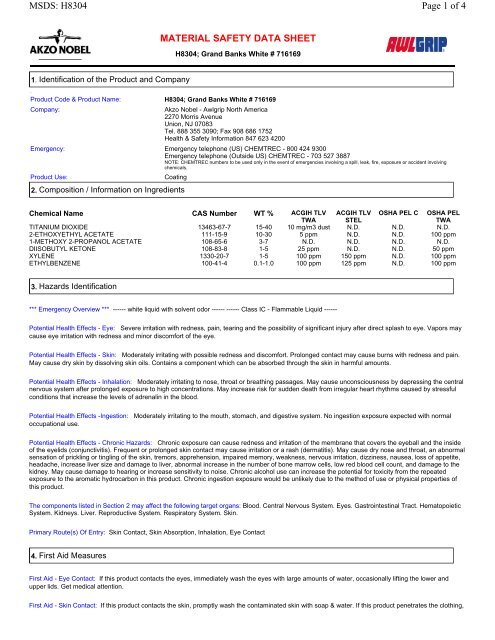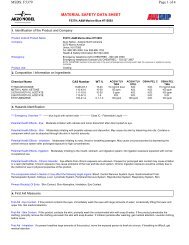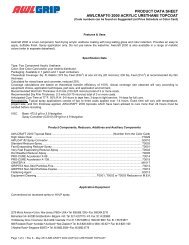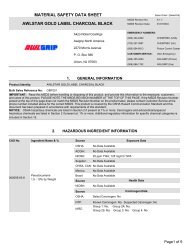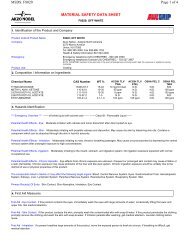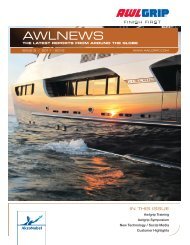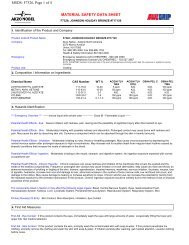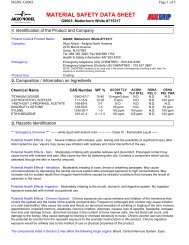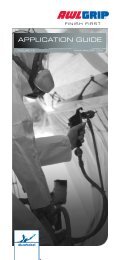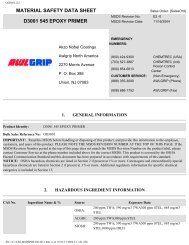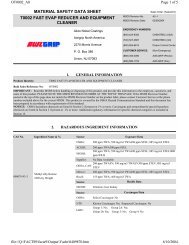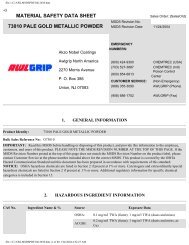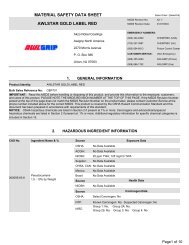H8304 - Awlgrip
H8304 - Awlgrip
H8304 - Awlgrip
Create successful ePaper yourself
Turn your PDF publications into a flip-book with our unique Google optimized e-Paper software.
MSDS: <strong>H8304</strong>Page 1 of 4MATERIAL SAFETY DATA SHEET<strong>H8304</strong>; Grand Banks White # 7161691. Identification of the Product and Company.Product Code & Product Name: <strong>H8304</strong>; Grand Banks White # 716169Company:Akzo Nobel - <strong>Awlgrip</strong> North America2270 Morris AvenueUnion, NJ 07083Tel. 888 355 3090; Fax 908 686 1752Health & Safety Information 847 623 4200Emergency: Emergency telephone (US) CHEMTREC - 800 424 9300Emergency telephone (Outside US) CHEMTREC - 703 527 3887NOTE: CHEMTREC numbers to be used only in the event of emergencies involving a spill, leak, fire, exposure or accident involvingchemicals.Product Use:Coating2. Composition / Information on IngredientsChemical Name CAS Number WT % ACGIH TLVTWAACGIH TLVSTELOSHA PEL C OSHA PELTWATITANIUM DIOXIDE 13463-67-7 15-40 10 mg/m3 dust N.D. N.D. N.D.2-ETHOXYETHYL ACETATE 111-15-9 10-30 5 ppm N.D. N.D. 100 ppm1-METHOXY 2-PROPANOL ACETATE 108-65-6 3-7 N.D. N.D. N.D. N.D.DIISOBUTYL KETONE 108-83-8 1-5 25 ppm N.D. N.D. 50 ppmXYLENE 1330-20-7 1-5 100 ppm 150 ppm N.D. 100 ppmETHYLBENZENE 100-41-4 0.1-1.0 100 ppm 125 ppm N.D. 100 ppm3. Hazards Identification*** Emergency Overview *** ------ white liquid with solvent odor ------ ------ Class IC - Flammable Liquid ------Potential Health Effects - Eye: Severe irritation with redness, pain, tearing and the possibility of significant injury after direct splash to eye. Vapors maycause eye irritation with redness and minor discomfort of the eye.Potential Health Effects - Skin: Moderately irritating with possible redness and discomfort. Prolonged contact may cause burns with redness and pain.May cause dry skin by dissolving skin oils. Contains a component which can be absorbed through the skin in harmful amounts.Potential Health Effects - Inhalation: Moderately irritating to nose, throat or breathing passages. May cause unconsciousness by depressing the centralnervous system after prolonged exposure to high concentrations. May increase risk for sudden death from irregular heart rhythms caused by stressfulconditions that increase the levels of adrenalin in the blood.Potential Health Effects -Ingestion: Moderately irritating to the mouth, stomach, and digestive system. No ingestion exposure expected with normaloccupational use.Potential Health Effects - Chronic Hazards: Chronic exposure can cause redness and irritation of the membrane that covers the eyeball and the insideof the eyelids (conjunctivitis). Frequent or prolonged skin contact may cause irritation or a rash (dermatitis). May cause dry nose and throat, an abnormalsensation of prickling or tingling of the skin, tremors, apprehension, impaired memory, weakness, nervous irritation, dizziness, nausea, loss of appetite,headache, increase liver size and damage to liver, abnormal increase in the number of bone marrow cells, low red blood cell count, and damage to thekidney. May cause damage to hearing or increase sensitivity to noise. Chronic alcohol use can increase the potential for toxicity from the repeatedexposure to the aromatic hydrocarbon in this product. Chronic ingestion exposure would be unlikely due to the method of use or physical properties ofthis product.The components listed in Section 2 may affect the following target organs: Blood. Central Nervous System. Eyes. Gastrointestinal Tract. HematopoieticSystem. Kidneys. Liver. Reproductive System. Respiratory System. Skin.Primary Route(s) Of Entry: Skin Contact, Skin Absorption, Inhalation, Eye Contact4. First Aid MeasuresFirst Aid - Eye Contact: If this product contacts the eyes, immediately wash the eyes with large amounts of water, occasionally lifting the lower andupper lids. Get medical attention.First Aid - Skin Contact: If this product contacts the skin, promptly wash the contaminated skin with soap & water. If this product penetrates the clothing,
MSDS: <strong>H8304</strong>Page 2 of 4promptly remove the clothing and wash the skin with soap & water. If irritation persists after washing, get medical attention. Launder clothing beforereuse.First Aid - Inhalation: If a person breathes large amounts of this product, move the exposed person to fresh air at once. If breathing is difficult, getmedical attention.First Aid - Ingestion: If this product has been swallowed, get medical attention immediately.5. Fire-Fighting Measures.Flash Point (F): 80 LOWER EXPLOSIVE LIMIT: 0.8UPPER EXPLOSIVE LIMIT: 15.0Extinguishing Media: Carbon Dioxide, Dry Chemical, FoamUnusual Fire And Explosion Hazards: Flammable Liquid. Vapors are heavier than air and may travel to a source of ignition and flash back.Special Fire Fighting Procedures: Firefighters and others exposed to vapors or products of combustion should wear self-contained breathing apparatus.6. Accidental Release MeasuresSteps To Be Taken If Material Is Released Or Spilled: Eliminate all ignition sources. Stop or control the spill, if this can be done without undue risk. Donot allow material to enter sewers or ground. Isolate discharged material for proper disposal. Wear appropriate personal protective equipment.7. Handling and StorageHandling: Grounding or bonding of containers is recommended before material transfer. Activities such as sanding, burning off etc. of paint films maygenerate dust and/or fumes hazardous to the skin and lungs. Work in well ventilated areas. Use local exhaust ventilation and personal skin andrespiratory protective equipment as appropriate.Storage: Storage areas should be dry and well-ventilated.8. Exposure Controls / Personal ProtectionEngineering Controls: It is recommended that work be done in an adequately ventilated area (i.e., ventilation sufficient to maintain concentrations belowone half of the PEL and other relevant standards). Local exhaust ventilation is recommended when general ventilation is not sufficient to control airbornecontamination.Respiratory Protection: Appropriate respirators must be used, and a program that follows 29 CFR 1910.134 or other applicable regulatory requirementsmust be followed, when workplace hazards warrant the use of a respirator. NIOSH-approved or other appropriate respirators must be used whenrespiratory protection is necessary.Eye Protection: Wear appropriate goggles, face shields or other PPE, which will be effective under the circumstances if the possibility of contact exists. Aprogram meeting 29 CFR 1910.133 or other applicable regulatory requirements must be followed when PPE is necessary.Other Protective Equipment: Use impermeable gloves and protective clothing as necessary to prevent skin contact.Hygienic Practices: Do not eat, drink, chew tobacco or gum, or apply cosmetics while working with this product. Wash hands before performing any ofthese activities.9. Physical and Chemical PropertiesTheoretical ValuesBoiling Range (F): 243 - 662 VOC (g/l)(less water & exempt): 453Freeze Point (F): N.D. VOC (lb/gal)(less water & exempt): 3.8Specific Gravity: 1.4 % Solids By Weight: 67Appearance: white % Solids By Volume: 50
MSDS: <strong>H8304</strong>Page 3 of 4Physical State: liquid Density (lb/gal): 11.4Odor:solvent.10. Stability and ReactivityConditions To Avoid: Avoid contact with heat, open flame, sparks, or ignition sources.Hazardous Polymerization: Will not occur.Stability: Stable.11. Toxicological InformationChemical Name LD50 LC50 IARC NTP OSHATITANIUM DIOXIDE Oral rat >10,000 mg/kg N.D.2-ETHOXYETHYL ACETATE Oral Rat: 2700 mg/kg Inhalation Rat: 12100 mg/m3/8H1-METHOXY 2-PROPANOL ACETATE Oral Rat: 8532 mg/kg N.D.DIISOBUTYL KETONE Oral Rat: 5750 mg/kg N.D.XYLENE Oral Rat: 4300 mg/kg Inhalation Rat: 5000 ppm/4H;ETHYLBENZENE Oral Rat: 3500 mg/kg N.D. Group 2B12. Ecological InformationAkzo Nobel has not conducted specific studies on the eco toxicity or environmental fate of this product. Commonly available data on certain ingredientsindicate that acute or chronic effects could result from uncontrolled releases to soil, ground water, storm waters, or air. Appropriate measures should betaken to prevent uncontrolled releases. Prompt containment and clean up should be performed if releases do occur.13. Disposal ConsiderationsLegal disposition of wastes is the responsibility of the owner/generator of the waste. Applicable federal, state, and/or local regulations must be followedduring treatment, storage, or disposal of waste containing this product. Do not dispose of in an uncontrolled manner.14. Transport Information.DOT Proper Shipping Name: Paint IATA Proper Shipping Name: Paint IMO Proper Shipping Name: PaintDOT Hazard Class: 3 IATA Hazard Class: 3 IMO Hazard Class: 3DOT UN Number: UN1263 IATA UN Number: UN1263 IMO UN Number: UN1263DOT Packing Group: III IATA Packing Group: III IMO Packing Group: IIIResp. Guide Page: 128 IATA Hazard Subclass: N/A Marine Pollutant: NoChemical Name CAS Number RQ (lbs)XYLENE 1330-20-7 100ETHYLBENZENE 100-41-4 100015. Regulatory InformationU.S. FEDERAL REGULATIONS: As follows -CERCLA - SARA Hazard Category: This product is considered, under applicable definitions, to meet the following categories: IMMEDIATE HEALTHHAZARD, CHRONIC HEALTH HAZARD, FIRE HAZARDSARA Section 313: This product contains the following substances subject to the reporting requirements of Section 313 of the Superfund Amendmentand Reauthorization Act of 1986 (SARA Title III) and 40 CFR 372:Chemical Name 313 Category CAS Number WT %2-ETHOXYETHYL ACETATE Glycol Ethers 111-15-9 21.4XYLENE 1330-20-7 2.5ETHYLBENZENE 100-41-4 0.6Clean Air Act: This product contains the following chemical substances listed as Hazardous Air Pollutants (HAPs) under the Clean Air Act of 1990:Chemical Name HAP Category CAS Number WT %2-ETHOXYETHYL ACETATE Glycol Ethers 111-15-9 21.4
MSDS: <strong>H8304</strong>Page 4 of 4XYLENE 1330-20-7 2.5ETHYLBENZENE 100-41-4 0.6Toxic Substances Control Act: All the components of this product comply with applicable requirements of the US EPA TSCA inventory.Contains (a) chemical(s) subject to the reporting requirements of TSCA 12b if exported from the US.U.S. STATE REGULATIONS: As follows -California Proposition 65: WARNING: This product contains chemicals known to the State of California to cause cancer and birth defects or otherreproductive harm.INTERNATIONAL REGULATIONS: As follows -Canadian WHMIS Class: B2, D2Canadian DSL - All the components of this product are listed or are exempt from listing.Korean Inventory - All the components of this product are listed or are exempt from listing.Australian AICS - All the components of this product are listed or are exempt from listing.16. Other Information.National Paint & Coatings Association (NPCA) Hazardous Material Identification System (HMIS):Health: 3 Flammability: 3 Reactivity: 0 Personal Protection: See Section 8Legend: N.A. - Not Applicable, N.D. - Not DeterminedThis MSDS relates only to the specific material identified in Section 2. In compiling this MSDS, Akzo Nobel has relied in good faith on informationprovided to Akzo Nobel by suppliers of the components of this material, and, in some cases, provided by independent data resources. Akzo Nobel hasnot independently verified such information, and, in addition, users should be aware that all materials may present unknown hazards. Use of thismaterial in combination with other materials and/or in specific processes may render information set forth in the MSDS inaccurate or otherwise invalid.NO WARRANTY, EXPRESS OR IMPLIED, IS MADE REGARDING THE INFORMATION FURNISHED ON THIS MSDS.Revision Date: 09/11/2006


